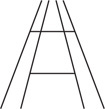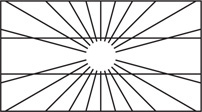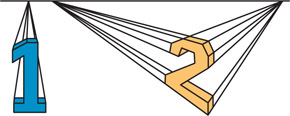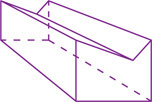In one-point perspective, the front of the cube is parallel to the drawing surface. A two-point perspective drawing generally looks like a corner view. For either type of drawing, you should be able to envision each vanishing point.
Exercises
Is each object drawn in one-point or two-point perspective?
Draw each object in one-point perspective and then in two-point perspective.
- a shoe box
- a building in your town that sits on a street corner
Draw each container using one-point perspective. Show a base at the front.
- a triangular carton
- a hexagonal box
Copy each figure and locate the vanishing point(s).
Optical Illusions What is the optical illusion? Explain the role of perspective in each illusion.
-

-

-
Open-Ended You can draw block letters in either one-point or two-point perspective. Write your initials in block letters using one-point perspective and two-point perspective.

Table of Contents
- 6-1 The Polygon Angle-Sum Theorems
- 6-2 Properties of Parallelograms
- 6-3 Proving That a Quadrilateral Is a Parallelogram
- 6-4 Properties of Rhombuses, Rectangles, and Squares
- 6-5 Conditions for Rhombuses, Rectangles, and Squares
- 6-6 Trapezoids and Kites
- 6-7 Polygons in the Coordinate Plane
- 6-8 and 6-9 Coordinate Geometry and Coordinate Proofs










